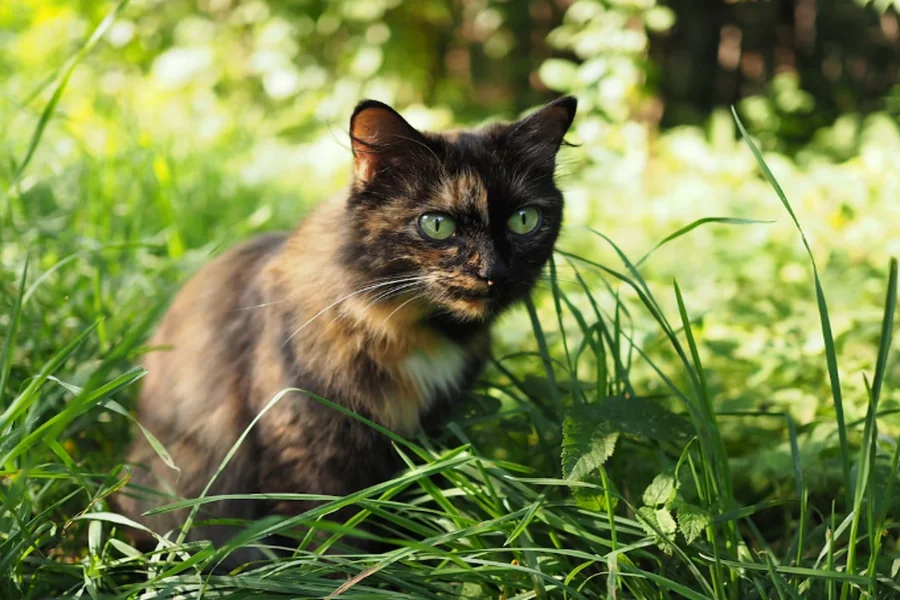You don’t have to compromise your cat’s health for a nice garden. The most popular garden flowers are very poisonous to your cat’s health, but with a little planning and selecting certain flowers wisely, you can have a wonderful garden that will not hurt your pet and bring it joy.
Toxic Garden Plants to Cats
Some favourite garden flowers will make your cat very sick, or even kill your cat. The poisonous plants are largely lilies, and Easter lilies, tiger lilies, and daylilies. Even minimal contact with pollen can lead to kidney failure in cats.
Azaleas and rhododendrons contain toxins that affect your cat’s cardiovascular and central nervous systems. Oleander is highly toxic, with cardiac glycosides in all parts of the plant that may kill your cat.
Tulips and daffodils may herald the coming of spring but hold poison in their bulbs. Garden cats that dig can be dangerously poisoned by these seemingly harmless flowers. Foxglove, so picturesque in the cottage garden, holds within its leaves and stems digitalis alkaloids that can cause feline heart problems.
Safe Plant Alternatives for Your Garden
Fortunately, there are many beautiful flowers that are absolutely nontoxic to cats, and you’ll see them utilised by a safe and secure cattery. Sunflowers add dramatic height and colour without any danger to curious cats. Marigolds add vibrant orange and yellow colour and also help to repel garden pests naturally.
Snapdragons provide vertical interest and come in numerous colours and are a wonderful alternative to toxic foxglove. For ground cover, use the catnip or catmint, which nearly all cats love and cannot have enough of.
Spider plants are excellent fillers for borders in the garden and in baskets. Your cat might nibble on them from time to time, but spider plants are nontoxic and easy to cultivate. Zinnias give you bright, cheery flowers all summer and draw beneficial pollinators to your garden.
Setting Up a Safe Garden Space
Aside from choosing plants, garden planning also keeps your cat safe. Provide areas where your cat can dig to fulfil its natural instinct, but not near the areas where you planted.
Install proper fencing for the vegetable beds and flower beds. This will keep the cats away from potentially toxic mulches that are made from cocoa shells, pesticides, or fertilisers, all of which are toxic to cats.
Consider raised beds for plants you enjoy. They hold plants above the ground level but also enhance your landscape garden. Mulching with cat-compatible materials like shredded bark or gravel also discourages digging.
Keeping a Cat-Safe Garden
Maintain your garden through regular upkeep to assist in keeping your outdoor area secure. Remove any dropped fruit from trees because some of the fruit will rot and be toxic. Compost piles need to be shut tightly because rotting organic matter will be appealing to cats and contain dangerous germs.
Monitor your garden closely for volunteer plants that will arise on their own. Weeds such as castor bean plants can be very dangerous if they get a foothold in your garden.
Store garden chemicals, fertilisers, and garden equipment in locked cupboards or sheds. Organics are also toxic to inquisitive cats that enjoy investigating containers or recently treated zones.
Creating Beauty Without Sacrifice
A cat-friendly garden need not sacrifice beauty or diversity. Numerous plants are non-toxic and offer brilliant colours, interesting textures, and nice scents that create a fun and interactive outdoor area for you and your cat to share.
Start creating your cat garden today by seeking out pet-friendly plant nurseries in your area. Your cat will thank you for taking the time to give them a play space that’s safe for their health, and you will have the added enjoyment of knowing that you’re a thoughtful pet owner.



